Exploring Allied Market Research’s Top 5 Emerging Markets in the Automotive and Transportation Domain in Q2 2024

The field of automotive and transportation has faced major challenges recently, but its quick adaptation has helped it overcome them easily. In the post-pandemic period, as the disposable incomes of the global population grew, the sphere of automotive manufacturing was able to revive itself and eventually automobile sales surged exponentially. Also, the rise in the volume of global trade has led to a drastic increase in the demand for different transportation modes including rail, road, shipping, and air travel. The resurgence of the tourism industry in the post-pandemic period has also directly impacted on the rise of the automation and transportation domain.
A major trend witnessed in the field of automobile manufacturing is the emergence and integration of emerging technologies like the Internet of Things, AI, machine learning, etc. These new electronic systems and innovations have given rise to new industries in the automotive and transportation sector. Recently, Allied Market Research, with the help of its in-house ‘Title Matrix Tool’, published a study that focuses on the top 5 emerging markets in the automotive and transportation sector based on the key parameters such as CAGR values and revenue numbers. Furthermore, each of these 5 industries is covered extensively through their reports with a special focus on growth drivers, investment opportunities, and the latest developments in the market.
Automotive Cybersecurity Market
As per the AMR report on the automotive cybersecurity market, the industry, which was valued at $7.23 billion in 2021, is expected to gather a revenue of $32.41 billion by 2030, thus growing at a CAGR of 16.6% from 2021 to 2023. In the past few years, several governments across the globe have launched initiatives to support connected car technologies which has helped the growth of the sphere in the second quarter of 2024. Secondly, a general rise in awareness regarding the need for vehicle security is predicted to amplify the growth rate of the market in the forecast period.
The report also highlights the various segments of the landscape on the lines of offering, security type, application, and form. By offering, the software segment is expected to be one of the most dominant in the coming period on account of the increasing deployment of different cybersecurity software applications for ensuring enhanced adaptive security. Major companies such as Robert Bosch GmbH, Arilou Automotive Cybersecurity, HARMAN International, etc., are also studied in the report and their strategies are discussed in order to help new businesses understand the complete picture of the industry.
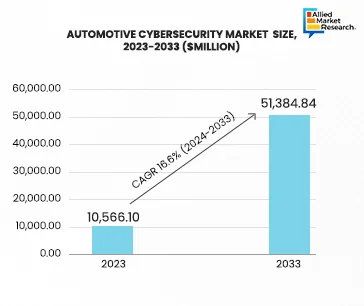
Smart Mobility Market
A recently published report on the smart mobility market states that the industry is anticipated to rise at a stunning CAGR of 20.2% from 2020 to 2027. The landscape accounted for $34.04 billion in 2019 and is set to gather a revenue of $70.46 billion by 2027 in the forecast period. The increasing shift toward on-demand transportation services is predicted to open new avenues of growth in the coming period. Furthermore, many governments have launched smart city initiatives in major metropolitan cities across the globe which are expected to augment the growth rate of the landscape by 2027.
An important part of the AMR report is the regional analysis of the market which deals with the performance of the industry in various regions of the globe including North America, LAMEA, Asia-Pacific, and Europe. As far as the smart mobility landscape is concerned, the Asia-Pacific region is estimated to have the highest growth rate of 22.2% from 2022 to 2027. As said earlier, many countries in the province such as Japan and South Korea have initiated schemes to promote the goal of smart cities, significantly enhancing the urban landscape.
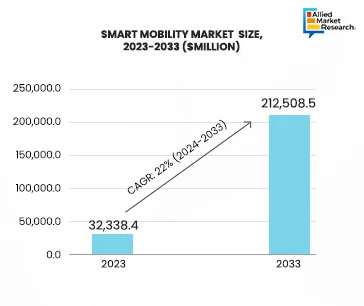
Shared Mobility Market
The use of different vehicles and modes of transportation such as cars, scooters, motorcycles, etc., on an as-needed basis is generally referred to as shared mobility. Thus, concepts of micro-mobility, public transit, car sharing or pooling, ride sharing, and micro-transit come under the ambit of shared mobility. The growing adoption of the shared mobility model of transportation in several urban areas and cities around the world has contributed to the rise of the market in the second quarter of 2024. The rise in venture capital and investments in these transportation models is expected to help the shared mobility market garner a revenue of around $1,266.80 billion by 2031, thus rising at a CAGR of 11.5% from 2022 to 2031 period.
Apart from the growth drivers and investment opportunities, the report also covers the various segments of the landscape on the lines of service model, vehicle type, vehicle propulsion, and sales channel. Based on the service model, the bike sharing segment is predicted to be the most lucrative in the near future, mainly due to the increasing adoption of eco-friendly transport solutions including electric bikes and bicycles. The growing investments in bike charging infrastructure are anticipated to impact the industry positively in the 2022-2032 period.
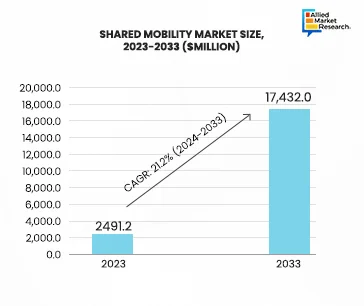
Self-Balancing Mobility Market
A recently published report on the self-balancing mobility market highlights that the landscape accounted for $1.53 billion in 2020 and is set to amass a revenue of $10.09 billion by 2030, thereby registering a CAGR of 21.2% from 2021 to 2030. The increased demand for micro-mobility around the world as a flexible and versatile mode of transport is expected to bring in new opportunities for growth in the coming period. Furthermore, a general rise in investments in battery technologies has improved the revenue share of the industry in Q2 2024.
An analysis of the performance of the landscape in different regions across the globe including LAMEA, North America, Asia-Pacific, and Europe is an important component of the AMR report. In the case of the self-balancing mobility industry, LAMEA is anticipated to have the fastest CAGR of 23.0% from 2021 to 2030. The rapid pace of urbanization has significantly changed the pattern of local commutation which has augmented the growth rate of the market in the province. Furthermore, the rising shift toward green mobility is also estimated to play a part in the expansion of the sphere in countries of Latin America, Africa, and the Middle East.
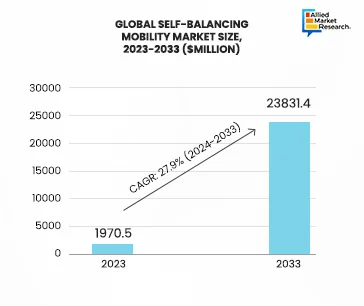
Electronic Toll Collection Market
Electronic toll collection system is an advanced technology that makes use of different solutions such as DSRC, GPS, GNSS, etc., for toll collection. This technology allows the driver to pay a toll for his/her vehicle without stopping at the toll plaza. The AMR report on the electronic toll collection market highlights that the landscape is set to surge ahead at a healthy CAGR of 10.7% in the 2018-2025 period. The rising demand for effective traffic management systems is expected to positively impact the realm of electronic toll collection in the years to come.
To help businesses operating in the industry, the report also profiles some of the multinational corporations such as CONDUENT (XEROX CORPORATION), EFKON GMBH, TRANSCORE (ROPER TECHNOLOGIES), CUBIC TRANSPORTATION, etc. Along with this, the segmental analysis of the landscape is on the lines of subsystem, technology, and application. The study of the market in various regions such as Asia-Pacific, LAMEA, Europe, and North America opens up new contours of the realm and shows different factors influencing it more clearly.
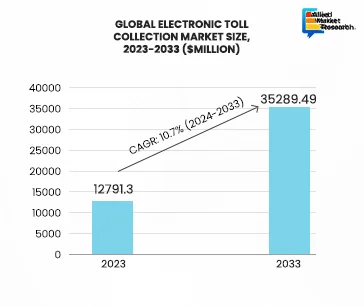
Analyzing the Competitive Scenario of the Automotive and Transportation Domain
Allied Market Research reports make use of scientific analytical tools like Porter’s five forces to provide companies with deep insights into the competitive scenario of the market. These insights enable businesses, especially new entrants, to understand how the multinational giants go on with their operations and thus, chalk out their plans accordingly. The study of the competitive scenario also shows the latest developments in the landscape, thereby aiding companies in formulating strategies for future growth. For instance, the advent of advanced traffic management systems is expected to help the electronic toll collection system industry flourish in the coming period.
In Summary
The actionable data offered by AMR reports aid businesses in realigning their operations as per the changing dynamics of the industry. Also, the reports focus on market restraints to guide investors and companies to avoid areas that might lead to challenges in maximizing their profits. Moreover, these AMR studies also feature interviews with the major stakeholders which helps businesses understand the upcoming trends in the landscape comprehensively.
For tips and recommendations on how businesses can capitalize on the opportunities in the automotive and transportation domain, contact our experts.



